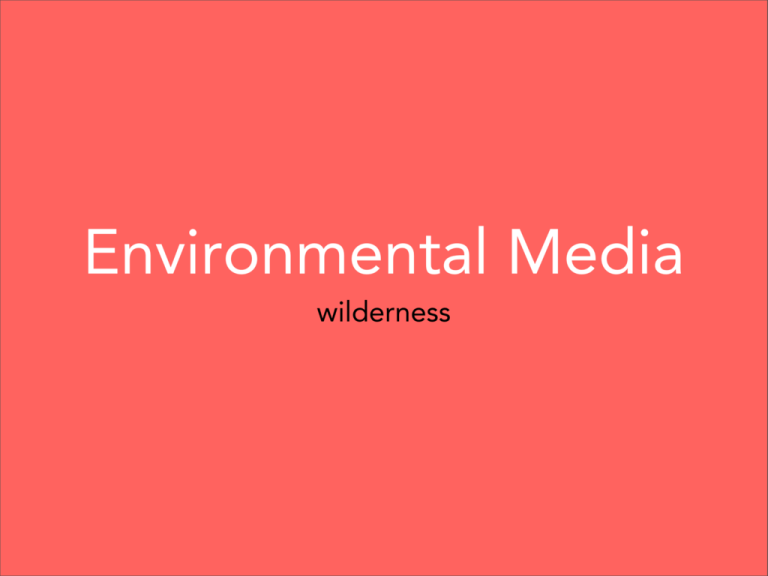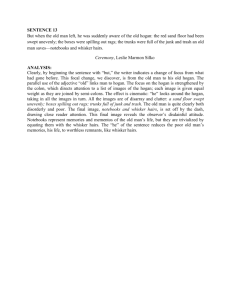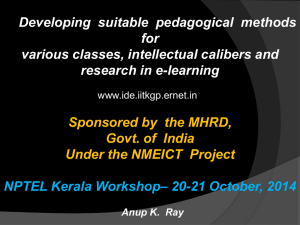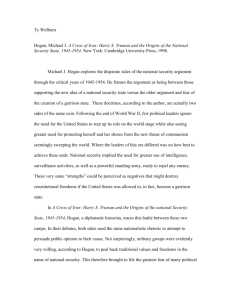EnviroMedia-03 Wilderness
advertisement

Environmental Media wilderness Mél Hogan www.melhogan.com 2014 / IIT readings William Cronon (1995). “The Trouble with Wilderness; or, Getting Back to the Wrong Nature” In William Cronon, ed., Uncommon Ground: Rethinking the Human Place in Nature, New York: W. W. Norton & Co., 1995, 69-90 (21 PAGES) John Scalan (2005) “Garbage Metaphorics” in On Garbage. Reaktion Books Ltd, UK. pp. 13-55 (42 PAGES) Optional: William Chaloupka and R. McGreggor Cawley (1993) The Great Wild Hope: Nature, Environmentalism, and the Open Secret. In: In the nature of things : language, politics, and the environment (1993) Jane Bennett and William Chaloupka, editors. University of Minnesota Press Minneapolis London. → Chapter 6 Going Wild: The Contested Terrain of Nature pp.111 Dipesh Chakrabarty, “The Climate of History: Four Theses,” Critical Inquiry 35 (2009). Mél Hogan www.melhogan.com 2014 / IIT http:// www.outsideonline.co m/outdoor-adventure/ media/Reboot-or-DieTrying.html Mél Hogan www.melhogan.com 2014 / IIT http:// www.elasticspace.com/ 2013/09/theimmaterials-project Mél Hogan www.melhogan.com 2014 / IIT http:// opinionator.blogs.nyti mes.com/2012/03/29/ nature-deficit-disorder/ Mél Hogan www.melhogan.com 2014 / IIT “ ...in less than a generation’s time, millions of people completely decoupled themselves from nature. http://opinionator.blogs.nytimes.com/2012/03/29/nature-deficit-disorder/ Mél Hogan www.melhogan.com 2014 / IIT Mél Hogan www.melhogan.com 2014 / IIT http:// www.cbsnews.com/ news/what-doesnatural-really-mean-onfood-labels/ Mél Hogan www.melhogan.com 2014 / IIT http://www.salon.com/2014/09/14/planet_earth_vs_roads_the_epic_conflict_that_will_define_the_future_of_the_world/ wilderness William Cronon “The Trouble with Wilderness; or, Getting Back to the Wrong Nature”In Uncommon Ground: Rethinking the Human Place in Nature, New York: W. W. Norton & Co., 1995, 69-90) The time has come to rethink wilderness. Mél Hogan www.melhogan.com 2014 / IIT Why? For many Americans wilderness stands as the last remaining place where civilization, that all too human disease, has not fully infected the earth. Mél Hogan www.melhogan.com 2014 / IIT https://upload.wikimedia.org/wikipedia/commons/3/36/Hopetoun_ Mél Hogan www.melhogan.com 2014 / IIT Remember the feelings of such moments, and you will know as well as I do that you were in the presence of something irreducibly nonhuman, something profoundly Other than yourself. Wilderness is made of that too. Mél Hogan www.melhogan.com 2014 / IIT https://www.youtube.com/watch?v=smFxLr-caeI https://www.youtube.com/watch?v=smFxLr-caeI Now let’s go back 250 years in American and European history... Mél Hogan www.melhogan.com 2014 / IIT Cronon (1995) shows that: ...strongest associations of wilderness then were biblical. ...a place to which one came only against one’s will, and always in fear and trembling. ...value arose solely from the possibility that it might be “reclaimed” and turned toward human ends vs. raw state. Mél Hogan www.melhogan.com 2014 / IIT parks Thoreau in 1862 declared wildness to be the preservation of the world... invites us to find a sense of meaning of direction and purpose in life through immediate contact with the living creatures leads to sympathy with intelligence lying outside the bounds of positive science, traditional philosophy, or conventional religiosity originary thinker in the philosophy of nonviolent civil disobedience environmental protest http://nationalhumanitiescenter.org/tserve/nattrans/ntwilderness/essays/preserva.htm Mél Hogan www.melhogan.com 2014 / IIT When John Muir arrived in the Sierra Nevada in 1869, he would declare: 1838 – 1914. ScottishAmerican naturalist, author, and early advocate of preservation of wilderness in the United States. “No description of Heaven that I have ever heard or read of seems half so fine.” ...various corners of the American map came to be designated as sites whose wild beauty was so spectacular that a growing number of citizens had to visit and see them for themselves Mél Hogan www.melhogan.com 2014 / IIT http://www.wyndham.com/property/XLVON/Images/42255_x1.jpg Mél Hogan www.melhogan.com 2014 / IIT Mél Hogan www.melhogan.com 2014 / IIT Yellowstone became the first national park in 1872. Mél Hogan www.melhogan.com 2014 / IIT The key to Yellowstone's future as a national park, though, was the 1871 exploration under the direction of the government geologist Ferdinand Hayden. Hayden brought along William Jackson, a pioneering photographer, and Thomas Moran, a brilliant landscape artist, to make a visual record of the expedition. Their images provided the first visual proof of Yellowstone's wonders and caught the attention of the U.S. Congress. Mél Hogan www.melhogan.com 2014 / IIT 1872 http://yellowstone.net/ history/files/ 2011/02/027351.jpg Mél Hogan www.melhogan.com 2014 / IIT 1872 http://yellowstone.net/ history/files/ 2011/02/027351.jpg Mél Hogan www.melhogan.com 2014 / IIT 1872 http://yellowstone.net/ history/files/ 2011/02/027351.jpg Mél Hogan www.melhogan.com 2014 / IIT “ Various tribes, in spite of their long association with the Park, were not consulted with regard to the creation of the Park. http://nativeamericannetroots.net/diary/688 Mél Hogan www.melhogan.com 2014 / IIT ownership vs inhabitation Mél Hogan www.melhogan.com 2014 / IIT 1903 He took the view that the President as a “steward of the people" should take whatever action necessary for the public good unless expressly forbidden by law or the Constitution As president, Roosevelt created five national parks (doubling the previously existing number); signed the landmark Antiquities Act and used its special provisions to unilaterally create 18 national monuments, including the Grand Canyon; set aside 51 federal bird sanctuaries, four national game refuges, and more than 100 million acres' worth of national forests. http://www.pbs.org/nationalparks/people/historical/roosevelt/ Mél Hogan www.melhogan.com 2014 / IIT http://www.nps.gov/ yose/historyculture/ Mél Hogan www.melhogan.com index.htm 2014 / IIT 1917 Clare Marie Hodges became the first female National Park Ranger at Yosemite. http://www.pbs.org/ nationalparks/ Mél Hogan www.melhogan.com 2014 / IIT media_detail/317/ 1920 “ Before the establishment of the National Park Service in 1916, the parks had existed as a haphazard collection of scenic places – occasionally guarded by the Army, often ignored by Congress, and in many ways controlled by the railroads that had funded much of the development in the parks. http://www.pbs.org/nationalparks/history/ep4/ Mél Hogan www.melhogan.com 2014 / IIT 1920 Mather, the first director of the National Park Service, was determined to change all that. He wanted more national parks within reach of more people, and he wanted them promoted as one cohesive system. http://www.pbs.org/ nationalparks/history/ Mél Hogan www.melhogan.com 2014 / IIT ep4/ What did he do? 1964 Wilderness Act http://www.wilderness.net/nwps/legisact?print=yes Mél Hogan www.melhogan.com 2014 / IIT sublime ...one of the most important expressions of that broad transatlantic movement we today label as romanticism. sublime a (1) : to elevate or exalt especially in dignity or honor (2) : to render finer (as in purity or excellence) b : to convert (something inferior) into something of higher worth In the theories of Edmund Burke, Immanuel Kant, William Gilpin, and others, sublime landscapes were those rare places on earth where one had more chance than elsewhere to glimpse the face of God. ...the strongest emotion which the mind is capable of feeling. ...because I am satisfied the ideas of pain are much more powerful than those which enter on the part of pleasure Edmund Burke (1729–1797). On the Sublime and Beautiful. The Harvard Classics. 1909–14. Mél Hogan www.melhogan.com 2014 / IIT In the theories of Edmund Burke, Immanuel Kant, William Gilpin, and others, sublime landscapes were those rare places on earth where one had more chance than elsewhere to glimpse the face of God. http:// www.iep.utm.edu/ kantaest/#SH2c Mél Hogan www.melhogan.com 2014 / IIT In the theories of Edmund Burke, Immanuel Kant, William Gilpin, and others, sublime landscapes were those rare places on earth where one had more chance than elsewhere to glimpse the face of God. The term "picturesque beauty" was originally defined in Gilpin's, The Essay on Prints (1768) http:// faculty.winthrop.edu/ kosterj/engl203/ overviews/sublime.htm He wrote the rules explaining how to paint or sketch a scene in nature to cause the right circumstances for reflecting on it in tranquility... http:// faculty.winthrop.edu/ kosterj/engl203/ overviews/sublime.htm Mél Hogan www.melhogan.com 2014 / IIT frontier Frederick Jackson Turner, "The Significance of the Frontier in American History"presented at a special meeting of the American Historical Association at the 1893 World's Columbian Exposition in Chicago. This hugely influential work marked a turning point in US history and culture, arguing that the nation’s expansion into the Great West was directly linked to its unique spirit: a rugged individualism forged at the juncture between civilization and wilderness, which for better or worse lies at the heart of American identity today. Mél Hogan www.melhogan.com 2014 / IIT The mythic frontier individualist was almost always masculine in gender: here, in the wilderness, a man could be a real man, the rugged individual he was meant to be before civilization sapped his energy and threatened his masculinity. http://www.pbs.org/weta/thewest/people/s_z/turner.htm Mél Hogan www.melhogan.com 2014 / IIT Mél Hogan www.melhogan.com 2014 / IIT This nostalgia for a passing frontier way of life inevitably implied ambivalence, if not downright hostility, toward modernity and all that it represented. Mél Hogan www.melhogan.com 2014 / IIT What does the end of the frontier mean? And for whom? For many women, Asians, Mexicans who suddenly found themselves residents of the United States, and, of course, Indians, the West was no promised land. http://www.pbs.org/weta/thewest/people/s_z/turner.htm Mél Hogan www.melhogan.com 2014 / IIT For the bourgeoisie... the frontier might be gone, but the frontier experience could still be had if only wilderness were preserved. Mél Hogan www.melhogan.com 2014 / IIT The dream of an unworked natural landscape is very much the fantasy of people who have never themselves had to work the land to make a living— urban folk for whom food comes from a supermarket or a restaurant instead of a field, and for whom the wooden houses in which they live and work apparently have no meaningful connection to the forests in which trees grow and die. Mél Hogan www.melhogan.com 2014 / IIT The myth of the wilderness as “virgin ” uninhabited land had always been especially cruel when seen from the perspective of the Indians who had once called that land home. http://yellowstone.net/history/files/2011/02/027351.jpg Mél Hogan www.melhogan.com 2014 / IIT The removal of Indians to create an “uninhabited wilderness”—uninhabited as never before in the human history of the place—reminds us just how invented, just how constructed, the American wilderness really is. Mél Hogan www.melhogan.com 2014 / IIT The central paradox: Wilderness embodies a dualistic vision in which the human is entirely outside the natural. Mél Hogan www.melhogan.com 2014 / IIT “If nature dies because we enter it, then the only way to save nature is to kill ourselves (p.13)” In groups, discuss how Cronon explains this impossible dualism? Cronon’s argument: We thereby leave ourselves little hope of discovering what an ethical, sustainable, honorable human place in nature might actually look like. Mél Hogan www.melhogan.com 2014 / IIT The Slums of Aspen: Immigrants vs. the Environment in America's Eden (Nation of Newcomers: Immigrant History as American History) by Lisa Sun-Hee Park (Author), David Naguib Pellow (Author) Mél Hogan www.melhogan.com 2014 / IIT nature John Scalan (2005) “Garbage Metaphorics” in On Garbage. Reaktion Books Ltd, UK. pp. 13-55 (42 PAGES) ...a human propensity for differentiation (a complicated way of saying we choose or accept something whilst rejecting something else) that inaugurates a lifetime of cuttingoff, disconnection and removal. Nevertheless, these activities become the principal means of marking off the valuable and worthy, and in this sense differentiation is what establishes culture. Mél Hogan www.melhogan.com 2014 / IIT According to Scanlan, what is garbage? In groups, find 3 key descriptors he uses to explain “garbage” and report these back to the class. How does Scanlan link the concept of ‘waste’ to those of ‘wilderness’ and ‘nature’? Look for terms like ‘human endeavor’, ‘ruin,’ ‘indeterminateness,’ ‘nature’s chaos,’ and ‘idleness’. Work in groups, and report back. (Hint: p22+) How does Scanlan link the concept of ‘garbage’ to ‘memory’? Work in groups, and report back. Icon Credits Covered wagon designed by James Keuning Indian designed by Simon Child Brush Harvesting and Hiker designed by Luis Prado Preservation designed by Donata Bologna Creation designed by Jakob Vogel American Flag designed by JB Map designed by DEADTYPE Car designed by Murali Krishna Farmer designed by Jerry Wang From the Noun Project thenounproject.com Mél Hogan www.melhogan.com 2014 / IIT







